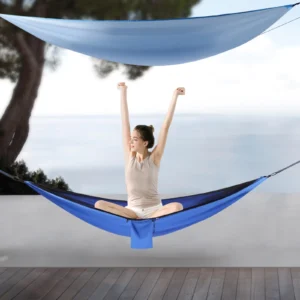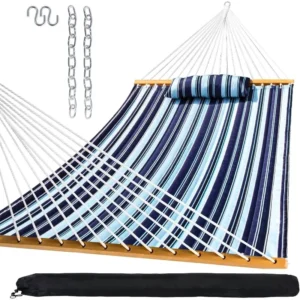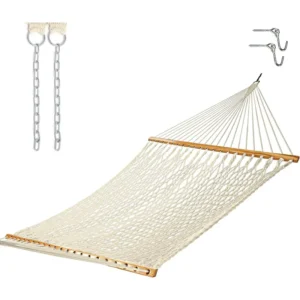Understanding Hammock Weight Limits: Safety First
When shopping for a hammock, one of the most important specifications to consider is the weight capacity. This isn’t just a random number—it directly impacts your safety, comfort, and how long your hammock will last.
Weight capacity refers to the maximum load a hammock can safely support during normal use. There’s an important distinction to make between static weight (when you’re sitting or lying still) and dynamic weight (the force created when jumping into a hammock or swinging aggressively).
Most manufacturers list their weight limits based on static load, assuming calm, reasonable use. When you exceed these limits, you risk:
- Damaged fabric, stitching, or suspension points
- Premature wear and tear that shortens lifespan
- Catastrophic failure leading to falls and potential injury
- Voiding manufacturer warranties
It’s worth noting that most hammock manufacturers build in safety margins, testing their products well beyond stated limits. However, regularly pushing these boundaries will compromise the structural integrity over time. Understanding hammock weight capacity guidelines is essential for anyone planning to spend significant time suspended.
The physics behind hammock weight support systems involves distributing force across fabric, stitching, and suspension points. For users requiring additional capacity, specialized heavy-duty hammock sets offer reinforced construction specifically designed for higher weight thresholds.
Single Hammocks: Compact Solutions for Solo Adventurers
Single hammocks represent the standard individual option in the hammock world. Typically measuring between 4-5 feet wide (1.2-1.5 meters) and 9-10 feet long (2.7-3 meters), these hammocks are designed primarily for solo use, striking a balance between comfort and portability.
The weight capacity of single hammocks generally falls into these ranges:
- Standard single hammocks: 300-400 pounds (136-181 kg)
- Ultralight single hammocks: 250-300 pounds (113-136 kg)
These capacity differences stem largely from the materials used. A hammock’s strength depends significantly on:
- Material type: Nylon varieties like ripstop offer excellent strength-to-weight ratios
- Denier rating: This indicates fabric thickness and strength—higher numbers mean stronger fabric
- Construction quality: Triple-stitched seams and reinforced attachment points boost capacity
Single hammocks excel in scenarios where weight and pack size are primary concerns, making them ideal for backpackers, hikers, and minimalist campers. Despite their “single” designation, they typically offer generous capacity for one adult plus some gear.

A common misconception is that single hammocks feel restrictive or cramped. In reality, a well-designed single provides ample space for most adults to find a comfortable diagonal position—the key to flat, ergonomic hammock sleeping. Understanding how much weight can hammock hold helps you make an informed choice based on your body type and gear requirements.
For those prioritizing minimal weight in their pack, Outside Luxe offers specialized ultralight camping hammock sets that maintain impressive capacity while reducing overall system weight.
Double Hammocks: Spacious Comfort for One or Two
Double hammocks expand on the single design, offering significantly more fabric width—typically 5-6.5 feet (1.5-2 meters)—while maintaining similar length dimensions of 9-11 feet (2.7-3.4 meters). This extra width translates directly into increased weight capacity and usable space.
The typical weight capacities for double hammocks include:
- Standard double hammocks: 400-500 pounds (181-227 kg)
- Heavy-duty double hammocks: 500+ pounds (227+ kg)
The increased fabric width in doubles doesn’t just support more weight—it fundamentally changes how weight distributes across the hammock. This creates a flatter, more stable lying surface that many users find more comfortable, even when used by just one person.
A key misconception is that double hammocks are exclusively for two-person use. In reality, many solo users prefer doubles for:
- Extra room to spread out
- Space for pets or gear
- Easier diagonal positioning for flat sleeping
- Reduced “cocoon” effect that can feel constrictive
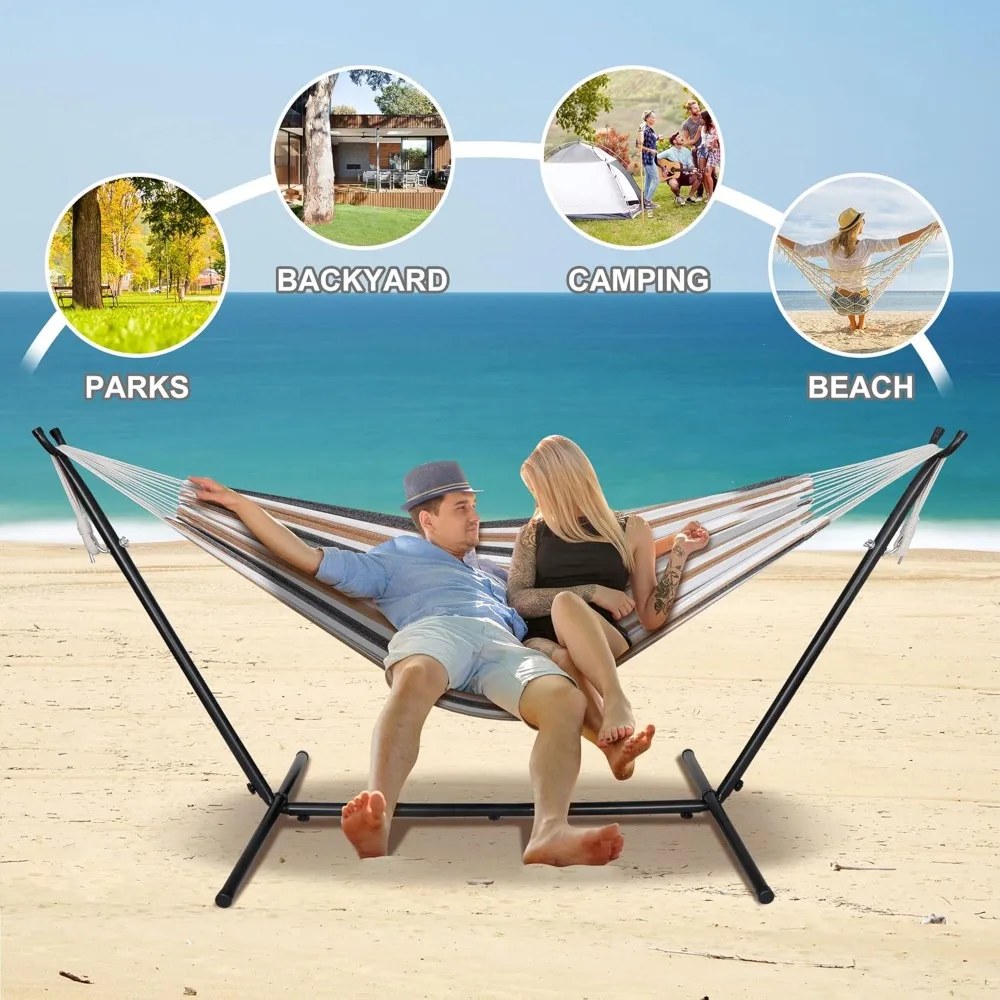
Survey data suggests that approximately 65% of solo hammock users eventually switch to double models for the added comfort, despite the small weight penalty. Understanding whether 2-person hammocks are worth it depends largely on your specific comfort preferences and usage scenarios.
For those ready to experience the spacious comfort of a two-person design, Outside Luxe offers premium double two-person hammock sets with reinforced construction and generous weight ratings.
Head-to-Head Comparison: Single vs. Double Hammocks
When deciding between single and double hammocks, understanding the key differences helps match the right option to your needs:
| Feature | Single Hammocks | Double Hammocks |
|---|---|---|
| Weight Capacity | 250-400 lbs (113-181 kg) | 400-500+ lbs (181-227+ kg) |
| Width | 4-5 ft (1.2-1.5 m) | 5-6.5 ft (1.5-2 m) |
| Length | 9-10 ft (2.7-3 m) | 9-11 ft (2.7-3.4 m) |
| Hammock Weight | 12-20 oz (340-567 g) | 20-35 oz (567-992 g) |
| Packed Size | Softball to grapefruit | Grapefruit to cantaloupe |
| Ideal Use | Solo backpacking, ultralight travel | Couples, comfort-focused solo users |
| Typical Price | $40-100 | $60-150 |
Beyond these specifications, comfort factors significantly influence the decision. Single hammocks create a snug, enveloping feel that some users prefer, while doubles allow more movement and flatter positioning that reduces the “banana” curve that can cause back discomfort.
Many users wonder if they should size up “just in case.” This depends on your priorities:
- If minimizing pack weight is crucial, stick with a single
- If comfort is paramount or you occasionally share, go double
- If you’re on the fence, the modest 8-16 ounce (227-454 gram) weight penalty of a double may be worth the versatility
Understanding safe hammock weight limits can help prevent dangerous situations, especially when sharing a hammock or using one near its capacity.
For those still unsure, Outside Luxe offers a variety of camping hammocks with stands in both single and double configurations, allowing you to find your perfect balance of capacity and convenience.
What Determines a Hammock’s Weight Rating? Technical Factors
The weight capacity of any hammock stems from multiple technical factors working together as a system:
Fabric Material and Construction
The primary material plays a crucial role in determining strength:
Nylon varieties: Ripstop nylon offers excellent tear resistance, while parachute nylon provides strength with some stretch. A 70D (denier) ripstop nylon can support approximately 40% more weight per square inch than standard parachute nylon.
Polyester advantages: Less stretchy than nylon with superior UV resistance, polyester maintains its strength better over time in outdoor settings.
Cotton limitations: While comfortable, cotton lacks the strength-to-weight ratio of synthetic materials, making it less suitable for technical applications requiring high weight capacity.
Thread Count and Denier
Denier (D) measures the thickness of individual fibers in the fabric—higher numbers indicate stronger, more durable material. For example, 40D ultralight nylon is significantly less robust than 210D heavy-duty fabric.
Stitching Techniques
How fabric panels connect dramatically impacts strength:
- Triple-stitched seams can increase weight capacity by up to 30% over single stitching
- Box-X stitching at stress points provides reinforcement where force concentrates
- Bartacking (dense zigzag stitching) at suspension points prevents catastrophic failure
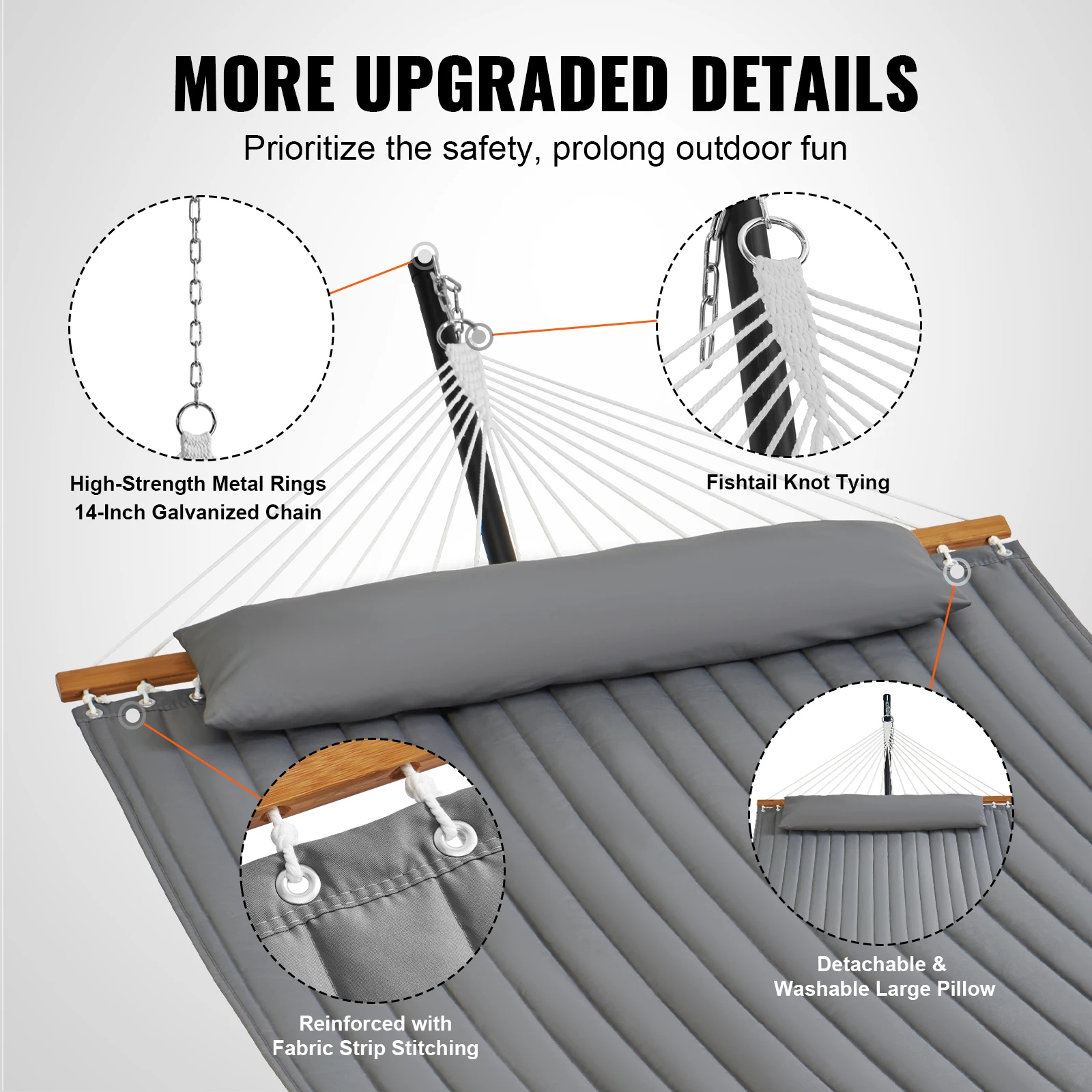
Suspension Systems
Even the strongest hammock body will fail if the suspension can’t match its capacity:
- Webbing straps typically have breaking strengths from 1,000-2,500 pounds
- Carabiners, hooks, and rings must meet minimum strength ratings
- Connection points where suspension meets hammock are common failure points
Understanding how hammock material vs weight capacity correlates helps you make informed decisions about durability versus weight tradeoffs.
For complete setups with properly matched components, Outside Luxe offers hammocks with stands where each element is rated for compatible capacity, eliminating guesswork.
Safety Considerations: Using Your Hammock Responsibly
Following proper safety protocols ensures your hammocking experience remains enjoyable and injury-free:
- Always respect manufacturer weight guidelines—they exist for your safety
- Calculate your total load: body weight + clothing + gear + pets
- Allow a safety margin of at least 50-100 pounds below rated capacity
- Remember that manufacturer ratings typically refer to static weight (sitting calmly), not dynamic forces (jumping in)
Signs that you may be approaching or exceeding weight limits include:
- Excessive fabric stretching or sagging
- Creaking or popping sounds from fabric or suspension
- Visible stress on seams or attachment points
- Difficulty achieving proper hang angle
Regular inspection is crucial for safety. Before each use, check for:
- Fraying or tearing in the fabric
- Loose or unraveling stitching at seams
- Wear at suspension connection points
- Damage to carabiners or other hardware
Different hanging environments create unique safety considerations. Tree mounting requires wide straps to protect bark, while indoor anchors must connect to structural elements like studs or joists, not just drywall.
For those interested in the science behind safe hanging, understanding hammock load capacity provides valuable insights into how forces distribute through the system.
Outside Luxe’s portable hammocks and stands provide consistent, reliable support without relying on environmental anchor points, making them ideal for situations where appropriate trees or mounting points aren’t available.
Choosing Between Single and Double: Decision Guide
Selecting the right hammock size depends primarily on how you’ll use it:
For Ultralight Backpacking/Hiking
- Choose single if: Minimizing pack weight is your priority and you’re comfortable with a snug fit
- Choose double if: You’re willing to carry 8-16 extra ounces for significantly more comfort and versatility
For Car Camping/Backyard Use
- Choose single if: You prefer a snug, cocooned feeling or have limited space
- Choose double if: Comfort is paramount or you occasionally share with a partner or child
For Primarily Sleeping vs. Lounging
- Choose single if: You’re a back sleeper comfortable with limited movement
- Choose double if: You’re a side sleeper, restless sleeper, or want to avoid the “banana curve”
Weight and Space Considerations
A 180-pound (82 kg) backpacker with 30 pounds (14 kg) of gear should look for capacities of at least 300 pounds (136 kg) for reasonable safety margin. Double hammocks typically require anchor points (trees, posts) to be at least 12-14 feet (3.7-4.3 meters) apart, while singles can work with 10-12 foot (3-3.7 meter) spans.
Budget Factors
While doubles typically cost 20-40% more than comparable singles, they often represent better long-term value for users who might eventually want more space.
Ultralight hammock camping design tips can help weight-conscious users optimize their systems regardless of hammock size.
For outdoor enthusiasts seeking protection from insects along with capacity, Outside Luxe offers camping hammock sets with bug nets in both single and double configurations.
Special Cases: Beyond Standard Weight Ratings
Some situations require specialized hammock solutions beyond typical single/double classifications:
Heavy-Duty Hammocks
For users needing exceptional capacity, specialized hammocks rated for 500-900 pounds (227-408 kg) feature reinforced construction, higher denier fabrics, and enhanced suspension systems. These designs often incorporate spreader bars or quilted layers for additional structural support.
Family Hammocks
Sometimes called “matrimonial hammocks,” these extra-large designs can accommodate multiple users with capacities up to 1,000 pounds (454 kg). Typically 8-10 feet (2.4-3 meters) wide, these massive hammocks require substantial anchor points and dedicated stands.
Hammock Stands and Weight Considerations
Stand weight ratings often differ from the hammocks they support. Steel stands typically support 400-600 pounds (181-272 kg), while wooden stands vary widely based on construction. Always verify that your stand matches or exceeds your hammock’s capacity.
Specialized Therapeutic Hammocks
For users with mobility issues or specific therapeutic needs, specialized hammocks with reinforced entry points, stability features, and custom weight distributions provide accessibility benefits beyond recreational use.
Outside Luxe understands diverse user needs and offers the ultimate guide hammocks for heavier individuals to help everyone find comfortable, safe options.
For turnkey solutions with precisely matched components, Outside Luxe’s complete camping hammock systems ensure every element meets capacity requirements.
A-Frame Stand Hammock Sets, Swinging Hammock Chair Sets
$154.62 Select options This product has multiple variants. The options may be chosen on the product pageCamping Hammock Sets with Bug Net, Ultralight Camping Hammock Sets
$139.72 Select options This product has multiple variants. The options may be chosen on the product pageClassic Wooden Stand Hammock Sets, Heavy Duty Hammock Sets
$1,061.68 Select options This product has multiple variants. The options may be chosen on the product pageHammock Sets with Canopy, Heavy Duty Hammock Sets
$286.31 Select options This product has multiple variants. The options may be chosen on the product pageDouble / Two Person Hammock Sets, Rope Hammock Sets
Double Traditional Cotton Rope Hammock with Extension Chains – 450 lbs Capacity for Backyard & Patio$292.98 Select options This product has multiple variants. The options may be chosen on the product page
Frequently Asked Questions
Can two adults safely use a single hammock?
While technically possible for brief periods if under the weight limit, it’s not recommended for comfort or safety. Single hammocks create a tight center point that forces two adults too close together, potentially exceeding capacity. Doubles are specifically designed for sharing with proper weight distribution.
Is a double hammock too big for one person?
Not at all—many solo users prefer doubles for the extra space and comfort. The additional fabric creates a flatter lying surface that many find more ergonomic for back support. The modest weight penalty (8-16 ounces/227-454 grams) is worth the comfort upgrade for many.
How much weight can hammock tree straps typically hold?
Quality tree straps usually have breaking strengths between 1,000-2,500 pounds (454-1,134 kg), significantly exceeding the capacity of most hammocks. The limiting factor is rarely the straps themselves but rather their attachment points to the hammock.
Does the way I hang my hammock affect its weight capacity?
Absolutely. A hammock hung too tightly (less than 30-degree angle) places excessive stress on fabric and anchor points, effectively reducing capacity. The optimal hang angle is approximately 30 degrees from horizontal, which properly distributes weight across the fabric.
What are the signs my hammock might be nearing its weight limit?
Warning signs include excessive fabric stretching, creaking sounds, visible stress on seams, difficulty achieving proper sag, and attachment point deformation. If you notice these indicators, reduce weight immediately.
For indoor setups, understanding if your ceiling can support a hammock is essential for safe installation.
Outside Luxe offers various lightweight hammock sets for users prioritizing capacity-to-weight efficiency.
Hammock Weight Limits in Real-World Conditions
Laboratory-tested weight capacities don’t always reflect real-world performance due to environmental factors:
Temperature Effects
Extreme temperatures affect material performance. Nylon can lose up to 15% strength in freezing conditions due to reduced elasticity, while polyester maintains more consistent properties across temperature ranges.
UV Exposure
Ultraviolet radiation degrades synthetic fibers over time. After 300 hours of direct sunlight exposure, nylon can lose up to 30% of its original strength. Regular inspection becomes increasingly important for hammocks used primarily outdoors.
Moisture Considerations
Wet nylon stretches significantly more than when dry, potentially changing weight distribution and putting stress on different areas of the hammock. This “sag factor” should be considered when using hammocks in humid or rainy environments.
Most hammocks will show signs of wear long before catastrophic failure. Look for these indicators that it’s time to replace your hammock:
- Visible thinning of fabric in high-stress areas
- Faded color (indicates UV damage)
- Stretched or deformed connection points
- Difficulty achieving proper tension
Understanding the differences between camping vs home hammock differences helps set appropriate expectations for durability in various environments.
For long-term durability in permanent setups, Outside Luxe’s quilted fabric hammock sets offer exceptional resilience to environmental factors.
Conclusion: Making Your Final Decision
When choosing between single and double hammocks, your decision ultimately depends on balancing capacity needs with your specific usage scenario. Singles excel in minimalist applications where every ounce counts, while doubles provide unmatched versatility and comfort with a modest weight penalty.
Regardless of which size you select, prioritize safety by:
– Choosing a hammock rated well above your anticipated load
– Following proper hanging technique
– Inspecting regularly for wear and damage
– Replacing aging equipment before failure occurs
Remember that the most comfortable hammock is one you can trust completely. Investing in quality construction pays dividends in both safety and longevity. The most comfortable hammock setup combines appropriate capacity with proper hanging technique.
For users valuing convenience alongside capacity, Outside Luxe offers premium quick-setup hammock sets that combine ease of use with reliable weight ratings.
By understanding the technical aspects of hammock weight limits and matching them to your specific needs, you’ll find the perfect balance of capacity, comfort, and confidence for countless relaxing hours suspended in blissful comfort.



